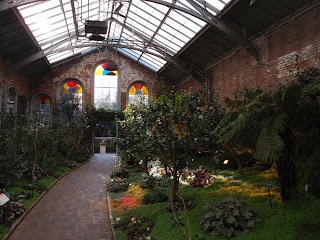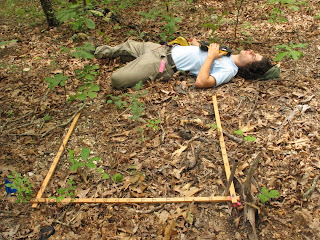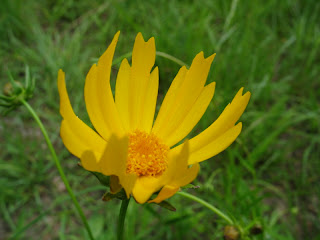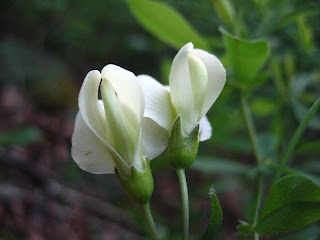Here is my new blog:
www.lukabotanical.blogspot.com
Sunday, August 30, 2009
Wednesday, August 26, 2009
The Botanical Adventure in Missouri is over
Thank you all very much for reading my blog, and for your support this summer. I had a great time.
I am interested in keeping a blog going about my photosynthetic friends. Let me know if you have any suggestions for how I can better organize the blog for your enjoyment. Any other comments on what you would like to see more of/less of, or any comment at all is welcome.
I am also interested in somehow including a database of plants that I will update containing my latest notes on identification or uses. Any suggestions?
Thanks again,
Luka
P.S. Here are some pictures from a trip to the Missouri Botanical Garden on my last day.



I am interested in keeping a blog going about my photosynthetic friends. Let me know if you have any suggestions for how I can better organize the blog for your enjoyment. Any other comments on what you would like to see more of/less of, or any comment at all is welcome.
I am also interested in somehow including a database of plants that I will update containing my latest notes on identification or uses. Any suggestions?
Thanks again,
Luka
P.S. Here are some pictures from a trip to the Missouri Botanical Garden on my last day.
Tuesday, August 18, 2009
It's getting to be that time...
My internship in Missouri is slowly coming to an end. There are only a few plots left to sample tomorrow, and then on Thursday a field trip to find some rare plants. This is it. I cannot believe it has gone by so fast.
From the very common Desmodium nudiflorum, to the many great friends, to the elusive Cypripedium reginae, this has been a wonderful summer. Yes, maybe I totalled a car, but it was a good learning experience because I didn't get hurt and insurance covered the cost.
I am excited and looking forward to see how the plant knowledge I may have aquired here in Missouri will face the plants of the northeast. If anything, maybe I'll know my graminoides by genus a bit better than before. :)
This blog isn't over yet, because I am still in Missouri, but I will let you know with an official last post. This blog may turn into the "Botanical Adventure of Maine" or even "of the World", but we'll see. I would like to keep a blog about my botanical interests going beyond Missouri.

From the very common Desmodium nudiflorum, to the many great friends, to the elusive Cypripedium reginae, this has been a wonderful summer. Yes, maybe I totalled a car, but it was a good learning experience because I didn't get hurt and insurance covered the cost.
I am excited and looking forward to see how the plant knowledge I may have aquired here in Missouri will face the plants of the northeast. If anything, maybe I'll know my graminoides by genus a bit better than before. :)
This blog isn't over yet, because I am still in Missouri, but I will let you know with an official last post. This blog may turn into the "Botanical Adventure of Maine" or even "of the World", but we'll see. I would like to keep a blog about my botanical interests going beyond Missouri.
Thursday, August 6, 2009
The Key to Gnat Protection
Spiders.
Yes spiders.
You may not understand or even hear my tone of voice but perhaps the following explanation will help.
Spiders have been a nuisance throughout the summer. Not the huge ground spiders, but the small ones that build invisible webs across any opening in the forest. I have to keep my arms up when walking so that their webs don't entangle my face and body. The feeling of web on skin is like the sensation of non-bubble chewing gum that you couldn't resist the temptation of blowing into the bubble that is now cemented your face. Except this feeling extends past the outer edges of your lips. Therefore, as beautiful as the spiders here are, there has still been frustration with their presence. Until recently, that is.
An even greater frustration are the gnats. They fly around your head in colonies, trying desperately to get into every orifice they can. One gets used to repeatedly inhaling, swallowing and digesting them. Eyelid reflexes also increase as attempts are made to close eyes before the Kamikaze gnats bury themselves between skin and eyeball.
Then, a discovery was made. While admiring a perfectly constructed web a few weeks ago, I noticed some small flies stuck in it. I had not noticed them before, but then realized why. The gnats around my head were flying into the web I was looking at. I realized the full potential of the spider's creation when I backed up and counted over thirty gnats stuck to the web and no longer buzzing around my head. Peace had been made with the spiders.
Now whenever anyone on the crew or I have a gnat problem, we seek a web and admire it closely in exchange for some silence.
Yes spiders.
You may not understand or even hear my tone of voice but perhaps the following explanation will help.
Spiders have been a nuisance throughout the summer. Not the huge ground spiders, but the small ones that build invisible webs across any opening in the forest. I have to keep my arms up when walking so that their webs don't entangle my face and body. The feeling of web on skin is like the sensation of non-bubble chewing gum that you couldn't resist the temptation of blowing into the bubble that is now cemented your face. Except this feeling extends past the outer edges of your lips. Therefore, as beautiful as the spiders here are, there has still been frustration with their presence. Until recently, that is.
An even greater frustration are the gnats. They fly around your head in colonies, trying desperately to get into every orifice they can. One gets used to repeatedly inhaling, swallowing and digesting them. Eyelid reflexes also increase as attempts are made to close eyes before the Kamikaze gnats bury themselves between skin and eyeball.
Then, a discovery was made. While admiring a perfectly constructed web a few weeks ago, I noticed some small flies stuck in it. I had not noticed them before, but then realized why. The gnats around my head were flying into the web I was looking at. I realized the full potential of the spider's creation when I backed up and counted over thirty gnats stuck to the web and no longer buzzing around my head. Peace had been made with the spiders.
Now whenever anyone on the crew or I have a gnat problem, we seek a web and admire it closely in exchange for some silence.
Saturday, July 25, 2009
Some Flowers...
Sunday, July 19, 2009
Road Stop

Our botany crew was invited to our boss Susan Farrington's house for dinner. On the way there we stopped on the side of a road to see a classic prairie species. The Liatris pycnostachya (Prairie Blazing Star).
The group of twelve that we are immediately disperse into the vegetation at the site of a new species we yet to have seen. (This is especially the case after we are no longer in the middle of a hot workday, and looking forward to a free homemade dinner!) Here are some pictures from the stop.

Crew members are deep in discussion about characteristics of an unknown plant.

Plant roadkill. Invasive plants are frequently uprooted and thrown across the pavement.

Our boss Susan (left) tells us about the Prairie Blazing Star.

Sunday, July 12, 2009
A Glade
The other day, one of our plots was right in the center of a dolomite glade. Dolomite is just a type of limestone that contains magnesium, so the soil in glades here is very calcareous. Glades are typically very dry and exposed, with very little overstory vegetation. They usually appear as grassy openings because of the high pH and shallow depth to the bedrock. Over time however, Red cedars (Juniperus virginiana), are slowly overgrowing glades. Regular forest fires help to maintain them by keeping the cedar population down.
The diversity of plants is also very high in glades, and unfortunately for us we usually have to spend up to four hours in the sun on just one glade plot. However, glades are a great way to learn a lot of new plants. Not only are there new plants there, but also new animals. We've seen numerous lizards, and last time we went we saw our first venomous snake in the field. Pygmy rattlesnakes are small and not as harmful as Timber rattlesnakes, but still as venomous. They just don't have as much venom to inject. We also found a tarantula den. The two that saw it first saw one of its legs coming out of the hole and they said it must have been larger than 1/8" thick! unfortunately I didn't see it.
The diversity of plants is also very high in glades, and unfortunately for us we usually have to spend up to four hours in the sun on just one glade plot. However, glades are a great way to learn a lot of new plants. Not only are there new plants there, but also new animals. We've seen numerous lizards, and last time we went we saw our first venomous snake in the field. Pygmy rattlesnakes are small and not as harmful as Timber rattlesnakes, but still as venomous. They just don't have as much venom to inject. We also found a tarantula den. The two that saw it first saw one of its legs coming out of the hole and they said it must have been larger than 1/8" thick! unfortunately I didn't see it.
Tuesday, June 23, 2009
Wonderful...
So... yeah.
The gravel roads here are definitely like driving over ball bearings. The road turned slightly at the top of the hill, and bumps in the road generated a washboard-effect. These factors together with maybe breaking a bit to fast soon sent my back end fish-tailing until I was perpendicular to the road. I continued to slide down, and as I approached the forest that was once to my right, but now in front of me, I just closed my eyes and held onto the wheel thinking "but this can't happen to me". Amazingly, I didn't get one scratch. My first reaction was complete frustration. As calmed down a few seconds later I realized what had happened. I noticed that the road was far and hidden behind a forest of trees and shrubs. I attempted to open the door, and although the door handle was invitingly stuck out in the open position, nothing would move. So, since my window was down, I climbed out.

Among the trees and shrubs I took with me, an eight inch Quercus coccinea was bent in half, ten feet behind where the car came to rest. There were also many Cornus florida in woods around me. Altogether, I probably plowed through about thirty feet of dense forest.
The gravel roads here are definitely like driving over ball bearings. The road turned slightly at the top of the hill, and bumps in the road generated a washboard-effect. These factors together with maybe breaking a bit to fast soon sent my back end fish-tailing until I was perpendicular to the road. I continued to slide down, and as I approached the forest that was once to my right, but now in front of me, I just closed my eyes and held onto the wheel thinking "but this can't happen to me". Amazingly, I didn't get one scratch. My first reaction was complete frustration. As calmed down a few seconds later I realized what had happened. I noticed that the road was far and hidden behind a forest of trees and shrubs. I attempted to open the door, and although the door handle was invitingly stuck out in the open position, nothing would move. So, since my window was down, I climbed out.

Among the trees and shrubs I took with me, an eight inch Quercus coccinea was bent in half, ten feet behind where the car came to rest. There were also many Cornus florida in woods around me. Altogether, I probably plowed through about thirty feet of dense forest.
Monday, June 22, 2009
Basic gear
 These are some of the basic tools for surveying a quad.
These are some of the basic tools for surveying a quad.- Meter^2 wooden frame
- Field computer for recording data
- Field book with pictures and notes about identifying the plants
- Personal notebook with notes about identifying the plants
Not in the picture:
- Compass for orienting the wooden frames and finding the quads
- Handlens to help with identifying plants
- Densiometer (a curved mirror used to estimate canopy coverage)
- Extra hot-pink flaging tape for marking old plots
- GPS device for finding the plots in the first place
Wednesday, June 17, 2009
Work is in full swing
The first few weeks of official training are over, and plot surveying has begun. Three others and I leave at seven each morning and get back at five in the evening. We begin our day by looking at a map of the plots we have to survey, and then program them into a GPS unit that will direct us to them. The plots are scattered at various sites in the Ozark forests. Each plot has four subplots, and each subplot has four quadrants. A quadrant is the square meter from which we survey plants and other data. Thus far together we have only been able to complete a maximum of four plots a day, which is about sixteen square meters of survey per person. We could definitely do more in one day, but this last week has been a series of severe thunderstorms and tornadoes that have cut our outside work by a few hours a day. While inside, we mounted herbarium specimens and studied new plants. To help us work faster, we are each given a field computer that we enter the data into from each quadrant. This includes the canopy coverage, the dead woody debris, the percent vegetation cover and the individual species of plants found.
I must say that repetitively identifying plants and writing out their Latin names is a surefire way of learning botany. Although it is quite exhausting, I am very pleased with this job and look forward to see how much this aids me with the Northeastern flora.
I must say that repetitively identifying plants and writing out their Latin names is a surefire way of learning botany. Although it is quite exhausting, I am very pleased with this job and look forward to see how much this aids me with the Northeastern flora.
Friday, May 29, 2009
Copperhead Search
One of my botany crew members and I went searching for Copperheads last night. They will come out at night and stretch out on the roads to absorb the heat the road has stored, or they just happen to frequently travel across them. We slowly drove down one of the gravel roads here at Peck Ranch, scanning the ground in front of us.
Although we didn't end up finding any Copperhead snakes, we found a few other interesting
things. (Note: you can click on all of these for a larger size.)

A strangely colored Yarrow (Achillea millefolium)

A Scarab or Dung beetle
A Whip-Poor-Will that let us get very close.

Although we didn't end up finding any Copperhead snakes, we found a few other interesting
things. (Note: you can click on all of these for a larger size.)

A strangely colored Yarrow (Achillea millefolium)

A Scarab or Dung beetle
A Whip-Poor-Will that let us get very close.

Sunday, May 24, 2009
Sensitive Plant
Here is a sensitive Mimosa quadrivalvis.
You can hear our instructor Susan Farrington talking in the background abut another plant.
You can hear our instructor Susan Farrington talking in the background abut another plant.
Friday, May 22, 2009
Orchid Expedition

Last night we went to search for the Showy Lady-slipper orchid (Cypripedium reginae). Someone had reported seeing some, but none were ever officially documented where we were. After a lot of bushwacking and stream treading, we found a few groups the Lady-slipper, but none were in complete bloom.

Finally someone spotted it in bloom....

Showy Lady-slipper orchid
Thursday, May 21, 2009
The Ozarks
(You can click on these for bigger pics)
A view from a fire watch tower. Can't see any clearings in the Ozark Forest as far as the eye can see.
Plant pics coming soon.
Wednesday, May 20, 2009
Botany training has begun...
Well, it really feels like I've just been dumped in a lake and I either have to learn to swim, or I'll sink. It is the third day and I have to know about 150 plants. Not only this, but most ID is only based on vegetative features because not everything has gone into flower yet. It is not so bad when all of the characteristics for each plant are pointed out in the field, but it requires a lot of studying in the evenings. The hardest ones are the graminoid plants like the grasses and sedges, but it is nice that the field features for all of these are being described so that ideally I wouldn't need to use more than a hand lens and ruler.
The regular day thus far is a plant quiz in the morning, and then the rest of the day (8:30-4:30) we learn plants in the field. Notes also consist of collected plant samples. I officially start sampling plots in a week from this Monday.
I will be posting some pictures soon.
The regular day thus far is a plant quiz in the morning, and then the rest of the day (8:30-4:30) we learn plants in the field. Notes also consist of collected plant samples. I officially start sampling plots in a week from this Monday.
I will be posting some pictures soon.
Saturday, May 16, 2009
Arrived at Peck Ranch
You know you are going south when the only kind of road kill you can recognize are upside down armadillos... every other mile.
I just arrived a few hours ago where I am going to live until August. One of my roommates is already here (he's been here since January), and he greeted me with a swollen, black and blue hand. Just last night he was outside, reaching for something on the ground, when a Copperhead struck. He's on all sorts of pain killers now. Ha... what a great welcome.
I was near St. Louis with some family friends for the last few days and yesterday I got to ride out on the Mississippi River! It was pretty amazing, but I have to say, lightning in the Northeast is nothing like what it is down here. Especially when you are stuck in a little dingy out on the huge Mississippi River, while thunderstorms are 360 degrees around you, it is pouring, and one bolt of lightning will spread like a tree across the entire sky.
Anyway, I left my powercord in St. Louis and I might not have internet contact when my computer dies.
I just arrived a few hours ago where I am going to live until August. One of my roommates is already here (he's been here since January), and he greeted me with a swollen, black and blue hand. Just last night he was outside, reaching for something on the ground, when a Copperhead struck. He's on all sorts of pain killers now. Ha... what a great welcome.
I was near St. Louis with some family friends for the last few days and yesterday I got to ride out on the Mississippi River! It was pretty amazing, but I have to say, lightning in the Northeast is nothing like what it is down here. Especially when you are stuck in a little dingy out on the huge Mississippi River, while thunderstorms are 360 degrees around you, it is pouring, and one bolt of lightning will spread like a tree across the entire sky.
Anyway, I left my powercord in St. Louis and I might not have internet contact when my computer dies.
Sunday, May 10, 2009
Done
After a long drive, I am back home in New York. Probably will be leaving for Missouri on Wednesday.
Luka
Luka
Thursday, May 7, 2009
Almost done...
I've attempted to put ten weeks worth of a school term into six weeks so that I can take the internship, which begins May 18. This last week has consisted of less than no sleep, but it has definitely been worth it. The classes I'm taking have been great fun and a lot of new learning. Ornithology and Climate Science. Well, anyway, I am almost done.....
Then I'll be off home to New York for a couple of days, and then to Missouri.
Then I'll be off home to New York for a couple of days, and then to Missouri.
Welcome!
Hello everyone,
Welcome to my blog.
Beginning on May 18, I am doing an internship in Missouri. I will be working for the Missouri Ozark Forest Ecosystem Project, surveying plants on forest management plots.
This project is part of a long term study surveying the effects of standard forest management on the various aspects of the Ozark Forest ecosystem.
I'm very much looking forward to this experience because I think it will be an excellent learning opportunity, and in a sense, a botanical adventure. I've never been to Missouri before, and I've never had such a rigorous full time job. I'm ready to give it what I've got.
I will try to get myself to post regularly about my botanical adventures in Missouri!
Luka
Welcome to my blog.
Beginning on May 18, I am doing an internship in Missouri. I will be working for the Missouri Ozark Forest Ecosystem Project, surveying plants on forest management plots.
This project is part of a long term study surveying the effects of standard forest management on the various aspects of the Ozark Forest ecosystem.
I'm very much looking forward to this experience because I think it will be an excellent learning opportunity, and in a sense, a botanical adventure. I've never been to Missouri before, and I've never had such a rigorous full time job. I'm ready to give it what I've got.
I will try to get myself to post regularly about my botanical adventures in Missouri!
Luka
Subscribe to:
Posts (Atom)








